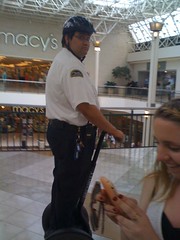Disclaimer: I am not a lawyer. In accordance with ABA policy, this blog should not be viewed as legal advice. It is simply my experiences, opinions, and information I looked up on the internet.
At 11:45pm on April 12, 2008, Mary Oberwetter and 17 friends engaged in silent dancing inside the Jefferson Memorial while listening to music on their headphones to celebrate Thomas Jefferson’s birthday. The Park Police arrested her when she refused their order to stop. Oberwetter was charged with interfering with an agency function and demonstrating without a permit, which violates the National Park Service Regulations. She responded by filing a lawsuit claiming that the police violated her First and Fourth Amendment rights. On May 17, 2011, the U.S. Court of Appeals affirmed the judgement that she was lawfully arrested and upheld the dismissal of her claims.
After the ruling came down, five more protesters were arrested for dancing in the Jefferson Memorial over Memorial Day weekend. The group, led by Adam Kokesh and Edward Dickey, referred to their behavior as civil danceobedience.
Many people, including Elie Mystal from Above the Law, found the ban on dancing in memorials disgusting. In response to the court ruling and the subsequent arrests, groups all over the world staged dancing events at memorials. It was reported that as many as 38 countries participated in the event, including demonstrations at the Jefferson Memorial and in Phoenix, Arizona. I could not find any reports of any arrests at any of the events.

Unfortunately the problem here is the law is clear that any demonstration at a memorial won’t be tolerated. It’s sad, but that’s what it is. This event made me wonder, on what grounds might someone be arrested for dancing in public and what can people to prevent it?
Assault: Assault requires intentionally, knowingly, or recklessly causing any physical injury to another person or placing them in reasonable apprehension of imminent physical injury. So as long as you keep your body at a sufficient distance from other people, I don’t think dancing constitutes assault.
Trespass: Trespass requires knowingly entering or remaining unlawfully on any real property after a reasonable request to leave by the owner or any other person having lawful control over such property, or reasonable notice prohibiting entry. Public property, like parks containing memorials, are open to everyone so as long as no person with proper authority, dance on!
Unlawful Assembly or Riot: These crimes require two or more people acting together with force or violence or threats of force that disturb the public peace. As long as you and your friends can dance without threatening anyone, then it’s ok.
Disorderly Conduct: This is a catch-all crime for general bad behavior; however, the law requires the intent to disturb the peace with unreasonable noise or violent or seriously disruptive behavior. I’m guessing you have to be a really bad dancer to rise to the level of seriously disruptive behavior.
Obstructing a Thoroughfare: To obstruct a thoroughfare, you have to recklessly interfere with the passage of a thoroughfare by creating an unreasonable inconvenience or hazard without a legal privilege to do so. Thus, dancing on the grass, away from the sidewalk or otherwise not interfering with other people’s ability to use the sidewalk because of your dancing appears to be permissible.

It’s important to note when you’re dancing at a memorial to look for any signage that indicated whether you are permitted to be on the memorial itself. In Bolin Park in Phoenix, there are over a dozen memorials and statutes. I was surprised that each one did not have a “Do Not Climb†plaque until someone pointed out that this notice was on the posted signs with all the rules regarding permitted behaviors in the park.
We had a great time at the dance event in Phoenix. There was another rally going on and there was lots of police and security present. At one point we went over to their area and started dancing on the lawn when they started to play music. The police looked at us strangely and smiled.
Thank you to Phoenix commercial photographer Adam Nollmeyer for shooting such awesome footage at the Phoenix Dance for Liberty Flash Mob.
Related articles
- Police Arrest 5 People At Jefferson Memorial — For Dancing (huffingtonpost.com)
- Thomas Jefferson Memorial Dance Sequel ? (2012patriot.wordpress.com)
- Video of Adam Kokesh dance flash mob at Jefferson Memorial, June 4, 2011 (via Dandelion Salad) (reclaimamericafromthelunaticfringe.wordpress.com)




